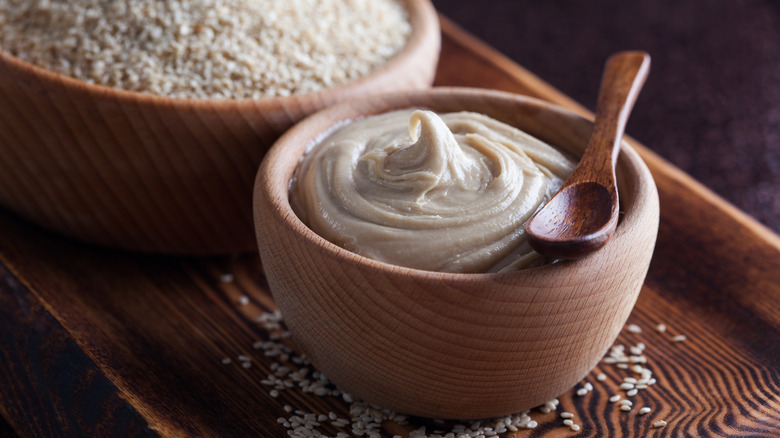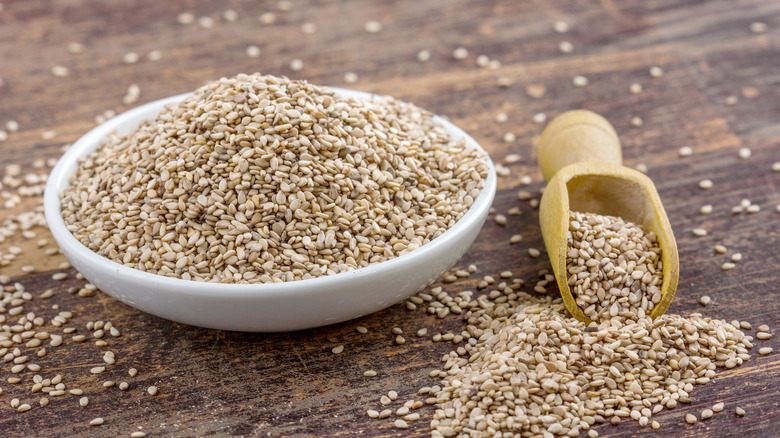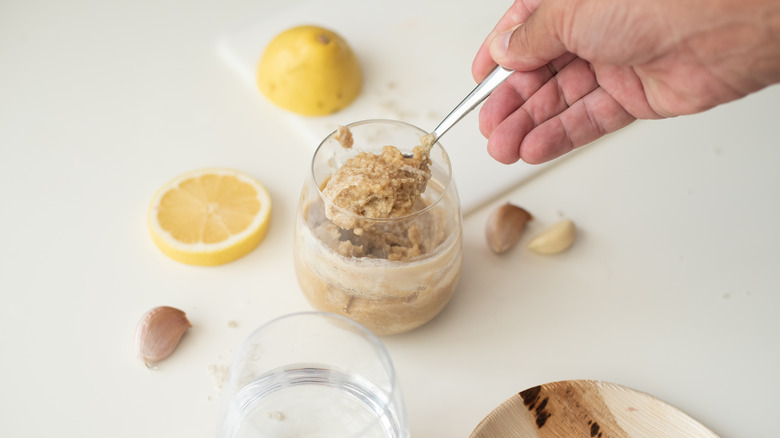The Different Types Of Tahini You Should Know About
With its creamy texture and rich aroma, tahini can be a delicious addition to sandwiches, salad dressings, baba ganoush, and soups. You can even try your hand at a tahini chicken thigh recipe, a quick meal that's just perfect for lunch or dinner. Alternatively, you can use this versatile ingredient as a substitute for ranch dressing or peanut butter.
Chances are, you're already using tahini in your go-to recipes. What you may not know is that it comes in different varieties, and each has a distinct flavor and consistency. The original version is made from roasted sesame seeds and has been around for thousands of years, notes Haaretz. Traditionally, the seeds are mechanically crushed into a paste and roasted at a low temperature. By comparison, organic tahini is made without roasting the sesame seeds or removing their outer husks, a process known as "hulling."
According to Bon Appétit, the best tahini has a nutty flavor and savory aroma — and it tastes so good that you can eat it as-is. Its texture should be similar to that of peanut or almond butter. Apart from that, it's important to know which type of tahini to use depending on what you want to cook.
The difference between hulled and unhulled tahini
Most tahini recipes only call for sesame seeds and olive oil, but some may also require salt, garlic powder, fresh lemon juice, or other ingredients. The main difference between the various types of tahini lies in how the seeds are processed. If you go to specialty stores, you'll likely find hulled or unhulled tahini and several other varieties, such as raw or roasted tahini, explains Gentle World.
Hulled sesame seeds have had the outer husks removed, which gives them a creamier texture. Unhulled seeds are intact and more nutritious, according to Mayver's. The former is lighter in color and has a smoother consistency and sweeter flavor than unhulled varieties. If you prefer a stronger, nuttier flavor, go for unhulled tahini. This version is also higher in fiber and calcium.
Unhulled tahini isn't widely available in grocery stores, but you can opt for sesame paste, which has a similar flavor and texture. This product is made from unhulled sesame seeds and boasts a deep, nutty aroma that can complement both sweet and savory dishes, notes Saveur. Alternatively, you can order unhulled tahini online, buy it from specialty stores, or purchase unhulled sesame seeds and make homemade tahini.
Should you use raw or roasted tahini?
Sesame seeds, whether hulled or whole, can be used raw or roasted, according to Gentle World. Depending on your preferences, you can go for light or dark roast varieties. Generally, light-roast unhulled tahini is slightly bitter, with a creamy texture, whereas dark-roasted varieties have a deeper flavor and more bitterness.
Light roast hulled tahini, on the other hand, is creamier and sweeter, which makes it suitable for homemade desserts. Dark-roasted varieties are more bitter and flavorful but not as bitter as unhulled tahini. This version also has a thick texture, so it's not the best option for salad dressing recipes, smoothies, or soups. However, it can be a wonderful addition to thick sauces, falafel, cookies, brownies, and more.
Regardless of which version you prefer, choose one that tastes good "in its raw state, straight out of the container," said chef Danielle Oron in an interview with The Strategist. She recommends Soom Foods' Pure Ground Sesame Tahini, Seed + Mill Organic Tahini, or the Tahini Sesame Paste from Beirut. Better yet, try to make tahini at home — it's quick, easy, and cheap. All you need is a high-speed blender and some basic ingredients you might already have in the kitchen.


